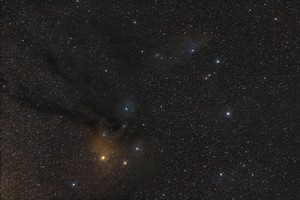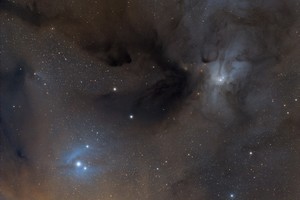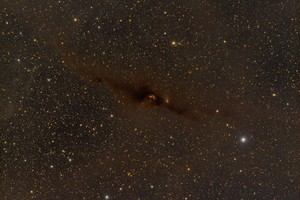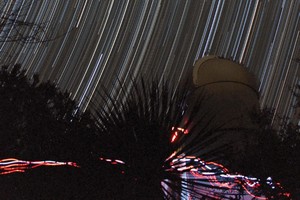Near Rho Ophiuchi is the topic of Part #1 of our image presentation, where we want to share the results from our astrophotography-trip to ATHOS Centro Astronómico at La Palma. In this part of our image presentation we want to show you some objects of the region surrounding the Rho Ophiuchi multiple star system, which is located in the constellation Ophiuchus.
The Rho Ophiuchi cloud complex is a dark nebula of gas and dust. At an estimated distance of only 400 light-years it is one of the closest star-forming regions to our solar system. This area is dominated by the yellow glowing star Antares (Alpha Scorpii) which has a visual luminosity of about 10,000 times of our Sun. The whole Antares - Rho Ophiuchi region is probably the most colorful and most beautiful region in our night sky!
IC 4604 is a large blue reflection nebula and part of the Rho Ophiuchi cloud complex. The nebula is illuminated by Rho Ophiuchi itself. IC 4605 is the small reflection nebula loacted between Antares and the huge dark nebula north of Antares. It has been detected by Edward Emerson Barnard in 1882. The blue reflection nebula cataloged as IC 4592 is also known as the Blue Horsehead Nebula. The nebula is illuminated by the star at the horse's "eye" - Nu Scorpii.
The next image shows a wide-field of the whole Scorpius region and the adjacent part of the Milky Way. Barnard 268 is one of many dark nebulas in constellation Ophiuchus. Beside Barnard 268 the following Barnard objects are visible in the wide-field image: 63, 64, 67A, 68, 69, 70, 71, 72, 74, 75, 77, 79, 80, 84, 259, 261, 262, 266, 270, 272, 276, 277 and 280.
Dark nebula LDN 43 is embedded in LBN 7. LDN 43 is the home of two red and nebulous objects: RNO 90 and RNO 91. The existence of RNO objects is a sign of star formation within this dark cloud.
At the end of part one of our image presentation from La Palma we want to show you the conditions of the night sky during our stay. The first image shows the conditions while Calima was active. Calima - also known as the Canary Islands Dust Storm - is a hot, oppressing dust and sand-laden, southerly to southeasterly, sometimes easterly wind in the Canary Islands region. It is particulary prevalent in winter. Like it's 'big brother' the Sirocco the Calima blows out of a high-pressure over Northern Africa and the Sahara and is normally drawn northwards ahead of a passing cold-front or depression north of the archipelago. It's fine yellowish-brown dust is even creeping through doors and windows. In rare conditions visibility can be reduced to null.
The second image shows the Milky Way and the excellent sky conditions during a clear night - without Calima. The last image is a typical star trail image from our observing site at ATHOS Centro Astronómico. Especially the light-trails in the lower part of the image - which results from our head lamps - make this image quite interresting.












